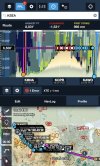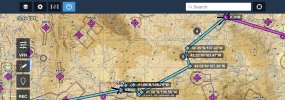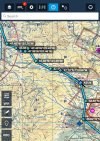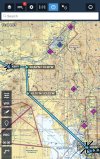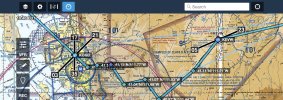I haven’t flown east-west across the country, but I have gone north-south a few different directions. There are some phenomenal sights to take in from the air. Mountains and storms are beautiful to see past your wingtip. The wildly varying landscape of the Colorado Plateau never ceases to amaze. Even the humble Ozarks blew me away the first time I flew over them. If you make the trip, keep your camera handy and don’t forget to post about it.
Are you instrument rated? Flyable IMC in the middle of the country is rare (unless you want to have the James Bond martini experience: iced up and shaken, not stirred), but the flight planning and route selection toolbox that comes with the instrument rating is helpful for a trip like this. The MEAs on airways are instructive for the altitudes and routes you can fly to avoid terrain. You can go lower and off-airways when you’re VFR, of course, but it really helps to understand the additional information on the IFR en route charts.
A few things to be aware of as you venture west:
* If you mostly fly east of the Great Plains, you probably cruise at 4,500 MSL and think that 7,500 MSL is higher than man was ever meant to go. By the time you get within sight of the Rockies, 4,500 will be pattern altitude and all the VFR traffic will be between 8,500 and 12,500.
* Get a pulse oximeter and use it to keep yourself aware of how your body is doing. A portable oxygen system is a good idea but I mostly use mine when I am IFR and have no choice but to go above 12,500 to avoid ice.
* Most of your airplane’s performance numbers are based on density altitude. Not just the takeoff numbers. If your service ceiling is 15,000, your indicated altitude is 12,000, and it’s warmer than standard (about -9C / 16F), you might be at the ceiling and your airplane won’t want to go higher.
* The desert is hot. Taking off from Phoenix, even in the late morning in January, can push your CHTs up into the discomfort zone.
* Loading to less than gross weight helps stack the deck in your favor (shorter takeoff, faster climb to a comfortable cruising OAT, higher service ceiling, etc.)
* Did I mention cruising OAT? Someone here on POA posted that he always climbs to an OAT of about 50F, whatever altitude that means. I don’t literally do this, but I’d rather be in smooth, comfortable, cool air with a headwind than bouncing around and rinsing vomit off the headliner with body sweat to save a few minutes.
* Try to keep the gas tanks full because the winds, broken or weird semi-self-serve fuel pumps, and all manner of other obstacles will conspire to eat up your reserves.
* Keep your eyes open for NORDO crop dusters taking off with tailwinds when you’re on final.

